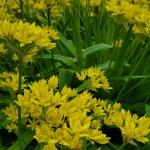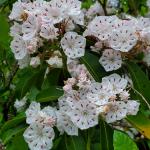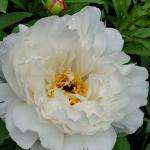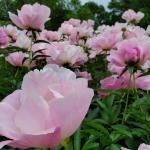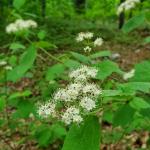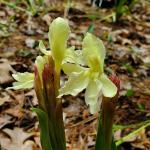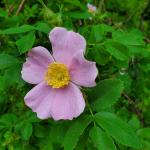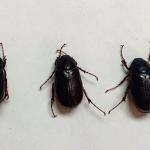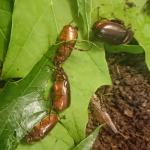UMass Extension's Landscape Message is an educational newsletter intended to inform and guide Massachusetts Green Industry professionals in the management of our collective landscape. Detailed reports from scouts and Extension specialists on growing conditions, pest activity, and cultural practices for the management of woody ornamentals, trees, and turf are regular features. The following issue has been updated to provide timely management information and the latest regional news and environmental data.
UMass Extension has developed a listing of resources for commercial horticulture operations in Massachusetts to help keep you informed and aware of relevant policies and best practices for landscapers, turf managers, arborists, nurseries, garden centers, and greenhouse producers.
For our COVID-19 Information and Support for Landscapers, Nurseries, Turf Managers, Garden Centers, Arborists, and Greenhouse Operations in Massachusetts, go to https://ag.umass.edu/landscape/news/covid-19-information-support-for-landscapers-nurseries-turf-managers-garden-centers.
The Landscape Message will be updated weekly in June. The next message will be posted on June 19. To receive immediate notification when the next Landscape Message update is posted, be sure to join our e-mail list.
To read individual sections of the message, click on the section headings below to expand the content:
Scouting Information by Region
Environmental Data
The following data was collected on or about June 10, 2020. Total accumulated growing degree days (GDD) represent the heating units above a 50° F baseline temperature collected via our instruments for the 2020 calendar year. This information is intended for use as a guide for monitoring the developmental stages of pests in your location and planning management strategies accordingly.
|
MA Region/Location |
GDD |
Soil Temp |
Precipitation
|
Time/Date of Readings |
||
|
1-Week Gain |
2020 Total |
Sun |
Shade |
|||
|
CAPE |
111 |
335 |
65 |
61 |
0.47 |
12:00 PM 6/10 |
|
SOUTHEAST |
125 |
392 |
80 |
67 |
0.55 |
5:30 PM 6/10 |
|
NORTH SHORE |
123 |
407.5 |
62 |
60 |
0.13 |
8:30 AM 6/11 |
|
EAST |
126.5 |
451.5 |
76 |
68 |
0.98 |
6:00 PM 6/10 |
|
METRO |
127 |
426.5 |
64 |
59 |
0.41 |
6:00 AM 6/10 |
|
CENTRAL |
125 |
414.5 |
60 |
56 |
0.25 |
7:15 AM 6/10 |
|
PIONEER VALLEY |
134 |
436.5 |
74 |
60 |
0.35 |
4:00 PM 6/10 |
|
BERKSHIRES |
118.5 |
391 |
65 |
61 |
0.62 |
8:00AM 6/10 |
|
AVERAGE |
124 |
407 |
68 |
62 |
0.04 |
_ |
|
n/a = information not available |
||||||
Updated on 6/11, this map of MA shows "Abnormally Dry" (D0) conditions exist in 8.5 of our 14 counties: https://droughtmonitor.unl.edu/CurrentMap/StateDroughtMonitor.aspx?MA
Phenology
| Indicator Plants - Stages of Flowering (BEGIN, BEGIN/FULL, FULL, FULL/END, END) | ||||||||
|---|---|---|---|---|---|---|---|---|
|
PLANT |
CAPE |
SE |
NS |
EAST |
METRO |
CENT |
PV |
BERK |
|
Kalmia latifolia (mountain laurel) |
Begin |
Full |
Full |
Begin |
Begin |
Begin |
Begin/Full |
* |
|
Cornus kousa (Kousa dogwood) |
Begin |
Full |
Begin |
Begin/Full |
Begin |
Begin/Full |
Full |
Full |
|
Chionanthus virginicus (fringe tree) |
Begin/Full |
Full |
Full |
Full |
Full |
Full |
Full |
Full |
|
Robinia pseudoacacia (black locust) |
Full |
Full/End |
Full/End |
Full/End |
Full/End |
Full |
End |
Full |
|
Deutzia spp. (Deutzia species) |
Full |
Full |
Full |
Full |
Full |
Full |
Full |
Full |
|
Weigela florida (old fashioned Weigela) |
Full/End |
Full |
Full |
Full |
Full |
Full |
Full |
Full |
|
Aesculus hippocastanum (common horsechestnut) |
Full/End |
Full/End |
End |
Full/End |
Full/End |
Full/End |
Full/End |
Full/End |
|
Enkianthus campanulatus (redvein Enkianthus) |
* |
* |
* |
Full |
* |
End |
End |
Full |
|
Rhododendron carolinianum (Carolina Rhododendron) |
End |
* |
Full/End |
Full/End |
Full/End |
Full/End |
Full/End |
Full/End |
|
Rhododendron catawbiense (Catawba Rhododendron) |
Full/End |
Full |
Full/End |
Full/End |
Full/End |
Full/End |
Full/End |
Full/End |
| * = no activity to report/information not available | ||||||||
Regional Notes
Cape Cod Region (Barnstable)
General Conditions: The average temperature during the period from June 3 – June 10 was 66˚F with a high of 81˚F on June 4 and low of 52˚F on June 8. The period was dominated by partly cloudy days with high relative humidity. Precipitation occurred primarily on June 6 with most areas receiving just under a half inch. More rain is needed as topsoil moisture is short. Tree pollen is still abundant, primarily pine at this time.
Pests/Problems: Lecanium scale females have grown into their distinctive hemispherical shape. The female scales are producing eggs and if you pop the scales off a twig a whitish powder of eggs can be seen. Some white oaks with heavy populations are showing symptoms of branch and twig dieback. A couple of small areas of defoliation on oak can still be seen in the upper Cape. The primary culprit appears to be cankerworm but there is also some winter moth damage. Winter moth appears to be done feeding. Other insect pests or damage noted over the period include black turpentine beetle damage on pitch pine, Viburnum leaf beetle defoliation on arrowwood Viburnum, rose slug sawfly larvae on rose, dogwood sawfly larvae on alternate leaf dogwood, elder shoot borer moth damage on elderberry, eriophyid mites on cherry and linden, and the first Asiatic beetle adults have been seen. Disease symptoms or signs observed over the period include sycamore anthracnose, maple anthracnose, brown rot on ornamental cherry, holly leaf spot (also natural leaf drop on holly), Exobasidium gall on Rhododendron, black spot on rose, and red thread on turf. White pine needle disease (other stresses also likely) is causing extensive needle loss on white pine. Weeds in bloom include black medic (Medicago lupulina), cypress spurge (Euphorbia cyparissias), chickweed (Stellaria media), white clover (Trifolium repens), creeping buttercup (Ranunculus repens), and Oriental bittersweet flowers are just about to open. If possible, remove Oriental bittersweet vines and roots before this invasive can offer countless berries to birds who innocently spread it everywhere. Other pests or pest damage seen include slugs on Hosta, rabbits on annuals and lots of dog ticks.
Southeast Region (Dighton)
General Conditions: Massive yellow clouds of white pine pollen, as well as copious quantities of sticky sap dripping on patio furniture and cars from male strobili, aiming to pollinate receptive female cones, makes one appreciate the evolution of flowering plants even more. It's well to remind frustrated clients that this season too shall pass and that pine sap can be removed with similar solvents. Cottonwood seeds are blowing on the wind, accumulating in now fluffy corners. Hay fields are getting their first mow resulting in the sweet smell of freshly cut fodder in the air. Soils are dusty dry after yet another meager rainfall total. Drought stress from the lack of rainfall can already be noticed on unirrigated turf. The first heat wave will be devastating. Where present, Poa annua already is becoming senescent and turning yellow. Despite the dry soils, humidity has remained high enough that sycamore trees have yet to fully leaf out due to anthracnose. Only the terminal leaves have emerged. The insects and other arthropods are starting to gain in numbers evidenced by the windshield test, although nothing like years ago before the use of insecticides decimated populations. Spicebush swallowtails, black swallowtails, hairstreaks, craneflies, syrphid flies and company are in the garden. Ruby throated hummingbirds can be seen feeding on columbine and catmint. The following plants are among those in flower: Medicado lupulina (black medic), Trifolium repens (white clover), T. pratense (pink clover), Silene latifolia (white campion), Celastrus orbiculatus (Oriental bittersweet), Hypericum perforatum (Saint John's wort), Dianthus deltoides (maiden pinks), Salvia nemorosa (perennial Salvia), Iris germanica (German Iris), I. siberica (Siberian Iris), I. pseudacorus (Yellow Flag), Cornus kousa (Kousa dogwood), Viburnum dentatum (arrowwood), V. plicatum (Japanese snowbell), Rhododendron spp. (Catawba Rhododendron and Delaware Valley white azalea), Chionanthus virginicus (American fringe tree), Cotinus coggygria (smoke bush), Physocarpus opulifolius (common ninebark), Linnaea amabilis, synonym Kolkwitzia amabilis (beauty bush), Weigela florida (Weigela), Deutzia spp. (Deutzia), Rosa spp., R. multiflora (the invasive Asian rambler rose), R. 'Knockout', R. virginiana (Virgina rose), R. rugosa (beach rose), Aesculus hippocastanum (horse chestnut), Robinia lutea (black locust), Coreopsis spp. (tickseed), Heuchera spp. (coral bells), Baptisia australis (blue false indigo), Allium spp. (ornamental onion), Aquilegia spp. (columbine), Nepeta spp. (catmints), Halesia Carolina (Carolina silverbell), Hemerocallis spp. (early daylily), Paeonia spp. (peony), Leucanthemum x superbum (shasta daisy), Conium maculatum (poison hemlock), Heracleum maximum/H. lanatum (cow parsnip - NOT to be confused with the dreaded giant hogweed), Prunus serontina (black cherry), Ranunculus repens (creeping buttercup), Viola tricolor (Johnny jump-up), common hawkweed, Achillea millefolium (yarrow), Cytisus scoparius (Scotch broom), Potentilla fruticosa (Potentilla), numerous grasses and bromes, Hesperis matronalis (dame's rocket), Clematis spp. (large-flowered Clematis), Papaver nudicaule (Iceland Poppy), P. sominferum (opium poppy), Kalmia latifolia (mountain laurel), Rubus spp. (brambles), Spirea spp. (bridal wreath), Lonicera sempervirens (native trumpet honeysuckle), Wisteria spp., Cerastium tomentosum (snow-in-summer), Tradescantia spp. (spiderwort), Myosotis spp. (forget-me-not), Glechoma hederacea (ground ivy), and Sedum spp. (prostrate yellow Sedum).
Pests/Problems: Drought stress is the biggest threat to landscapes right now. Be sure to calibrate your irrigation systems. You really don't know how much water you're applying unless you've measured the output. Pine pollen, for those allergic to it, is very irritating to eyes, nose and throats; another reason to wear a dust mask. This is not exactly Southcoast, but I've been surveying trees along transportation corridors recently on the South Shore and I'm surprised at the number and extent of dying ash trees. If you have ash trees you want to try to keep, do not delay. Also noted were aphids on Rosa 'New Dawn' and Clematis wilt.
North Shore (Beverly)
General Conditions: The weather during this reporting period was a mix of sunny and cloudy days. The average daily temperature for 6/3 – 6/10 was 67℉. The first half of the reporting period was much warmer, with a daily average temperature of 73℉. The second half of the week was cooler with an average daily temperature of 62℉. The highest temperature of 87℉ was recorded on Saturday, June 6 and the lowest temperature of 52℉ was recorded on Monday, June 8. Conditions are still dry and very little rain has been received during this period. At Long Hill, 0.10 and 0.03 inches of rain fell on Friday, June 5 and Monday, June 8, respectively. Because of the dry conditions, grass on exposed lawns is turning brown due to drought stress. Some woody plants observed in bloom include: horse chestnut (Aesculus hippocastanum), mountain laurel (Kalmia latifolia), several azaleas and Rhododendrons (Rhododendron spp.), Chinese dogwood (Cornus kousa), beautybush (Kolkwitzia amabilis/Linnaea amabilis), Weigela (Weigela florida), silver bells (Styrax japonicus) and Deutzia (Deutzia spp.). Herbaceous plants observed in bloom include: garden peony (Paeonia lactiflora), Allium (Allium spp.), fetterbush (Leucothoe fontanesiana), Rodgersia (Rodgersia spp.), Baptisia (Baptisia spp.), Clematis (Clematis spp.), ox eye daisy (Leucanthemum vulgare) and money plant (Lunaria annua).
Pests/Problems: Skeletonized leaf damage by Viburnum leaf beetle larvae continued to be observed on American cranberry Viburnum and Arrowwood Viburnum. Leaf and flower galls (Exobasidium vaccinii) continue to be observed in considerable numbers on some azaleas. Prune out the galls and discard in trash (not compost) before they turn white and start to release spores. Multiflora rose (Rosa multiflora) and wild raspberry (Rubus rosifolius) weeds are in full bloom and are easy to identify. Ticks and mosquitoes are very active. Make sure you protect yourself with appropriate repellants before you go out into areas with vegetation, especially out in the woods.
East Region (Boston)
General Conditions: We have had warm days and cool nights with some instances of high humidity. There was one major weather event on June 6 when a front came through delivering thunderstorms, high winds and 0.91” of precipitation. We gained 126.5 GDDs this week for a total of 451.5 GDDs for the year. Low temperatures ranged from 48°F to 66°F, averaging 56°F; high temperatures ranged from 68°F to 90°F, averaging 81°F. Crataegus spp. (hawthorn), Kolkwitzia amabilis (beauty bush) and Philadelphus coronarius (mock orange) are flowering. The eye-catching dappled willow (Salix integra ‘Hakuro-Nishiki) is producing a flush of white foliage.
Pests/Problems: Dry soils remain a concern. The majority of the 0.98” of precipitation we received this reported period fell over a relatively short period of time and did not adequately penetrate most soils. Viburnum leaf beetle larvae continue to feed on susceptible Viburnum foliage. There is an abundance of cottony Camellia/Taxus scale (Pulvinaria floccifera) throughout the landscape. White cottony egg masses have been observed on Euonymus, holly, Rhododendron and Taxus (yew).
Metro West (Acton)
General Conditions: We continue to experience summer-like temperatures rather than late spring like temperatures during this reporting period, with warm and dry weather. I recorded the first temperature in the 90s for the season on June 6th with 90°F. The monthly average precipitation for June is 3.93” and we are at 0.51” as of the 9th. Despite the lack of rain, the landscape is lush - green and filled with color! Observed in some stage of bloom this past week were the following woody plants: Aesculus x carnea (red horsechestnut), A. hippocastanum (horsechestnut), Calycanthus floridus (Carolina allspice), Chionanthus retusus (Chinese fringetree), C. virginicus (American fringetree), Cornus kousa (Kousa dogwood), Cornus sericea (redosier dogwood), Cotinus coggygria (smoketree), Crataegus viridis ‘Winter King’ (green hawthorn), Gymnocladus dioica (Kentucky coffee tree), Kalmia latifolia (mountain laurel), Leucothoe axillaris (coast Leucothoe), Philadelphus coronarius (sweet mock orange), Physocarpus opulifolius (common ninebark), P. opulifolius 'Summer Wine' (summer wine ninebark), Potentilla fruiticosa (Potentilla), Prunus serotina (black cherry), Rhododendron spp. (Rhododendron and azalea), Rosa gallica (French rose), R. glauca (shrub rose), R. 'Knockout' (Knockout family of roses), Rosa rugosa (beach rose), Rosa spp. (rose), Rubus spp. (bramble, blackberry), Spiraea japonica 'Alpina' (Daphne spirea), S. spp. (bridal wreath), Syringa spp. (lilac), Viburnum cassinoides (witherod Viburnum), V. dentatum (arrowwood Viburnum), Viburnum plicatum var. tomentosum (doublefile Viburnum), V. sargentii (Sargent Viburnum), and Weigela florida (old fashioned Weigela).
Woody vines observed in bloom were: Aristolochia macrophylla (Dutchman’s pipe), Clematis spp. (Clematis), Lonicera sempirvirens (native trumpet honeysuckle), and Wisteria spp. (Wisteria). Contributing even more color and interest to the landscape are some flowering herbaceous plants including: Allium spp. (ornamental flowering onion), including Allium giganteum (giant onion) and A. schoenoprasum (chives), Amsonia hubrichtii (Arkansas blue star), Aquilegia canadensis (native columbine), Aquilegia spp. (other columbines), Aruncus aethusifolius (goat’s beard), A. dioicus (goat’s beard), Baptisia australis (false blue indigo), Centaurea montana (cornflower, batchelor’s button), Cerastium tomentosum (snow-in-summer), Chrysogonum virginianum (green and gold), Delphinium spp. (larkspur), Dianthus deltoides (maiden pink), Dicentra eximia (fringed bleeding heart), D. spectabilis (old fashioned bleeding heart), D. spectabilis ‘Alba’ (white old fashioned bleeding heart), Dictamnus albus (gas plant), Filipendula spp. (meadow sweet), Geranium cantabrigiense 'Biokovo' and 'Cambridge' (hardy cranesbill), G. maculatum (wild Geranium), G. macrorrhizum (bigroot Geranium), G. sanguineum (cranesbill Geranium), Hemerocallis spp. (daylily), Iris germanica (bearded Iris), I. sibirica (Siberian Iris), Lupinus 'Russell Woodfield Hybrids' (lupine), Maianthemum racemosum (false Solomon seal), Nepeta spp. (ornamental catmint), Paeonia spp. (peony), Papaver orientale (Oriental or opium poppy), Phlox divaricata (Canadian Phlox), P. stolonifera (creeping Phlox), Sibbaldiopsis tridentate - formerly Potentilla tridentata - (three leaf cinquefoil), Primula spp. (primrose), Salvia nemerosa (Salvia), Saponaria ocymoides (rock soapwort), Thymus praecox (thyme), and Tradescantia spp. (spiderwort).
Pests/Problems: According to the US Drought Monitor map released on June 11, the Metro West area is experiencing abnormally dry conditions and some potential impacts are the following: crop growth is stunted, planting is delayed, fire danger is elevated, lawns brown early, gardens begin to wilt and surface water levels decline. Observed in the landscape this past week were evidence of anthracnose on Platanus (sycamore) and dieback on Pinus strobus (Eastern white pine).
Central Region (Boylston)
General Conditions: We are stuck in an early summer weather pattern of scattered thundershowers, high humidity and heat with little to no precipitation. Temperatures were well into the 80s for the majority of the reporting period. A brief but intense thunderstorm on Saturday afternoon, June 6, brought 0.25 inches of rain, but with such dry conditions preceding it, most of the precipitation ran off and provided little relief for dry soils. Across the region, garden plants are showing signs of drought stress. At the same time, we are in a period of heavy early summer blooms. Native plants in bloom this reporting period include Hypoxis hirsuta (yellow star grass), Iris versicolor (blue flag iris), Kalmia latifolia (mountain laurel), Liriodendron tulipifera (tulip tree), Rosa virginiana (Virginia rose), Viburnum acerifolium (maple leaf Viburnum), V. dentatum (arrowwood Viburnum), and Wisteria frutescens (American Wisteria).
Pests/Problems: The biggest threat to landscape plants at the moment is the onset of drought. We have not received any significant rainfall in about a month. Watering is a daily necessity, especially for newly planted and establishing plants in the landscape. We have little chance of rain in the long-range forecast. Pests observed this week include rose slugs, birch sawfly, and small numbers of gypsy moth.
Pioneer Valley Region (Easthampton)
General Conditions: June rolls on in the Pioneer Valley as we settle into summer. The days are especially long right now, leaving ample time in the evening hours to garden. Warm and humid weather persisted last week from 6/3 into 6/6. Temperatures hovered primarily in the mid-80s with uncomfortable dew points. A fast-moving band of strong thunderstorms brought some much needed rain on 6/6, but the rain came hard and passed quickly. Total accumulation was minimal (<0.4"), especially given the long dry stretch we’re enduring. Passing showers the day before, during the early morning hours of 6/5, brought only trace amounts of accumulation. Soils are increasingly dry and the primary focus right now is providing supplemental water for plants in need. Watering even smaller landscapes is a tedious task, especially as we enter weeding season. Mature and established trees and shrubs appear to be doing quite well, for now, tapping moisture in the lower soil horizons. The most recent update from the U.S. Drought Monitor shows the entire Pioneer Valley in the D0 (abnormally dry) classification (https://droughtmonitor.unl.edu/CurrentMap/StateDroughtMonitor.aspx?MA). The NWS Climate Prediction Center is predicting above-average precipitation in its 8–14 day outlook, so hopefully this holds true. As the humidity cleared during the afternoon of 6/6, it became quite windy late in the day. Wind damage to young, tender shoots from the storm was observed on beautyberry (Callicarpa), panicle Hydrangea (Hydrangea paniculata ‘Tardiva’) and Euonymus. After a brief cool down on 6/7 and 6/8, which also had persistent afternoon winds, temperatures were back on the rise from 6/9 to 6/10 with the hope for more rain on 6/11 at the time of writing. An amazing array of color continues in the landscape and it’s continuing to be a great year for Rhododendrons and azaleas. Mountain laurels are having their turn now and the mild winter left many plants heavily budded. Young trees and shrubs under irrigation are doing well, continuing to push new growth and taking advantage of the plentiful sun. The annual “summer snow” in the valley, aka cottonwood seed dispersal, is taking place right now. While not common in the landscape, the big cottonwoods that line the Connecticut River and its tributaries are magnificent trees. Several eastern black swallowtail (Papilio polyxenes) caterpillars were found on dill (Anethum graveolens). Swallowtails prefer members of the celery family (Apiaceae), which includes parsnip, fennel, wild carrot and celery.
Pests/Problems: Aphid activity is increasing on a number of plants. White pines are shedding large volumes of yellow/brown needles at this time, due to needle blight infections that took place last year. Sycamores are still struggling to push new growth throughout the valley, regardless of location, due to sycamore anthracnose. Based on limited scouting, there appears to be very little damage from the oak shothole leafminer. Last year’s outbreak of this uncommon insect was really surprising but it appears the outbreak may have been short-lived. Scout for evidence of spruce spider mite feeding on spruce, fir, hemlock, arborvitae and falsecypress. As a cool season mite, the damage should be readily visible now if feeding occurred earlier this spring. A registered miticide should be used to reduce the impact on beneficial, predatory insects. Continue to scout for and treat hemlocks for hemlock woolly adelgid and the increasingly more important elongate hemlock scale. Orange-colored spore masses of cedar-quince rust and cedar-apple rust can still be observed on Juniperus. These spores will disperse to infect rosaceous hosts and like many rust spores, they can travel considerable distances. Rodent tunneling is locally high this year and some recent trapping in my home garden (mulched beds with trees, shrubs, perennials and annuals) yielded the northern short-tailed shrew (Blarina brevicauda). The mild winter may have resulted in lower overwintering mortality for many rodents, including mice and chipmunks. Shrews will tunnel below the surface of the soil and occupy a variety of habitats, including managed landscapes. They may even colonize vole and mole tunnels. While voles can be destructive to plants (eating roots and girdling the lower trunk) and moles primarily consume insects, shrews eat seeds, insects, worms, other small mammals, and even fungi. Black fly and mosquito populations appear unaffected by the dry conditions and continue to annoy.
Berkshire Region (Great Barrington)
General Conditions: A very brief but torrential rain fell on the afternoon of Saturday, June 6 but the amount of rain varied depending on location. Most of the storm was limited to the central and southern parts of the county. At this site in West Stockbridge, 0.62 inches was collected; Richmond reported 0.40 inches: Pittsfield Airport recorded 0.21 inches; North Adams had only 0.03 inches. Where it fell, the rain was welcomed but quickly ran off any sloped surface due to the intensity of the downfall. Some erosion was noticed on slopes lacking vegetation. The rain helped droughty soils a bit but the benefit was not lasting as heat built up in following days, hastening evaporation of soil moisture and leaving behind a crusty soil surface. The precipitation deficit for year-to-date, as recorded at the Pittsfield Airport amounts to 5.37 inches. However, as mentioned in the last report, growth and appearance of landscape plants appears normal. There are no signs of drought stress with the exception of recently planted plants which have not benefited from follow-up irrigation. Growth of turfgrass is noticeably slower but little or no browning or dormancy is apparent yet.
Pests/Problems: One benefit of the dry conditions this spring has been the absence or very slow development of foliar plant diseases. For example, apple scab infections were noted in the early stages of leaf development on crabapples but have advanced very little since then. The first symptoms of apple-cedar rust can be seen on crabapple foliage but the infections are sparse. Heavy needle drop was observed on white pines at one site, suggesting possible needle blight (See the report under Woody Ornamentals in last week’s Landscape Message). Pests observed this week: Hydrangea leaf tier, spruce spider mite, woolly beech aphid, willow leaf beetle larvae and adults, Viburnum leaf beetle larvae, and aphids on a variety of woody and herbaceous plants. Compared to the large number of adult flies of boxwood leaf miners observed last week, few adults could be seen flying about this week, suggesting that the bulk of egg laying in the newly developed leaves is near completion. One strategy for controlling this pest is to prune the new foliage. However, since egg-laying typically extends to late June, it is advisable to delay pruning for another week.
Regional Scouting Credits
- CAPE COD REGION - Russell Norton, Horticulture and Agriculture Educator with Cape Cod Cooperative Extension, reporting from Barnstable.
- SOUTHEAST REGION - Brian McMahon, Arborist, reporting from the Dighton area.
- NORTH SHORE REGION - Geoffrey Njue, Green Industry Specialist, UMass Extension, reporting from the Long Hill Reservation, Beverly.
- EAST REGION - Kit Ganshaw & Sue Pfeiffer, Horticulturists reporting from the Boston area.
- METRO WEST REGION – Julie Coop, Forester, Massachusetts Department of Conservation & Recreation, reporting from Acton.
- CENTRAL REGION - Mark Richardson, Director of Horticulture reporting from Tower Hill Botanic Garden, Boylston.
- PIONEER VALLEY REGION - Nick Brazee, Plant Pathologist, UMass Extension Plant Diagnostic Lab, temporarily reporting from Easthampton.
- BERKSHIRE REGION - Ron Kujawski, Horticultural Consultant, reporting from Great Barrington.
Woody Ornamentals
Diseases
The UMass Plant Diagnostic Lab remains closed at this time. When the lab reopens, we will share this information widely.
Continue to scout for and report possible sightings of beech leaf disease, especially in coastal regions, where the disease is most prevalent right now. Hosts include American beech (Fagus grandifolia), European beech (F. sylvatica) and Japanese beech (F. crenata). Symptoms first appear in the lower canopy as dark green, interveinal banding. This is in contrast to beech anthracnose, woolly beech aphid infestations and erineum gall mites. Over time, the leaves become distorted and crinkled before they die and are shed from the canopy. The disease has been confirmed from a number of locations in southern Connecticut.
Scout for black knot of Prunus, caused by the fungal pathogen Apiosporina morbosa. The current season’s swollen cankers are becoming more visible now. At present, they still appear green-brown but are rapidly enlarging, clearly standing out from healthy stem tissue. In many cases, they are expanding from older, blackened cankers. Prune the cankered stems and discard to reduce inoculum in the canopy. Ornamental and orchard cultivars of plum (P. domestica) are most severely affected by the disease but certain ornamental and orchard cherries can also be badly diseased.
Carefully examine thin-barked ornamental trees and shrubs, such as Japanese maple, for dead stems and branches. From afar, these trees may look completely healthy but on closer examination, numerous dead stems may be present within the interior canopy. Prune and discard these stems, as they can harbor cankering pathogens like Phomopsis, Cytospora and Botryosphaeria. While these fungi are opportunistic, stress-related pathogens, the mounting dry conditions can weaken plant defenses.
Scout for symptoms of Dutch elm disease in American elm and Verticillium wilt in maples. Many landscape trees may be actively containing outbreaks of these diseases, only to be overwhelmed when stressed by drought, root severing/compaction, insect feeding and other diseases. Symptoms of DED can appear as yellowing of isolated, upper canopy branches and as a rapid wilting and browning of entire branches on younger trees. For Verticillium wilt, leaf curling, browning and wilting typically develops in isolated parts of the canopy, progressively spreading to larger branches. Sadly, the UMass campus lost its largest American elm this spring due to Dutch elm disease. The Point elm had a dbh >50”, was >75’ tall and had a roughly 80’ canopy spread. The tree was regularly scouted for DED symptoms and when present, upper branches were quickly removed. It also received preventative and therapeutic fungicide injections at various times over the years. It was an exceptional tree but just one of countless mature elms lost to DED over the decades.
Report by Nick Brazee, Plant Pathologist, UMass Extension Plant Diagnostic Lab, UMass Amherst.
Insects
A New Opportunity for Online Learning about Invasive Insects!
Join UMass Extension’s Landscape, Nursery, and Urban Forestry Program and UMass Extension’s Fruit Program for an exciting FREE series of seven webinars focusing on the impact, monitoring, and management of invasive insects in Massachusetts and the nation! Topics include the spotted lanternfly, spotted wing drosophila, brown marmorated stink bug, emerald ash borer, gypsy moth, Asian longhorned beetle, and more! Webinars will be held from Noon-1:00 PM on May 21, May 28, June 4, June 9, June 16, June 23, and June 30, 2020. Each webinar in this series offers 1 pesticide credit (categories 29, 35, 36, and applicators (core)) and MCA/MCLP’s earn 0.5 education credits for each webinar. ISA and SAF credits are available.
The fifth webinar in this series will happen LIVE on:
Tuesday, June 16, 2020
The Invasive Pest Brown Marmorated Stink Bug in Massachusetts: Biology, Monitoring, and Management
Elizabeth Garofalo, UMass Extension Fruit Program), and Dr. Jaime Pinero, UMass Stockbridge School of Agriculture and UMass Extension Fruit Program
The Brown Marmorated Stink Bug is a highly pervasive pest that can cause severe losses for both conventional and organic growers in a wide variety of crops. This webinar will discuss BMSB biology, distribution, monitoring, and management options that are amenable to both non-organic and organic production systems.
Don’t miss this excellent opportunity! For more information about all of the webinars in this series, to register, and to see archived recordings for any that you missed, visit: https://ag.umass.edu/landscape/education-events/invasive-insect-webinars
Really Cool Insects Reported This Week:
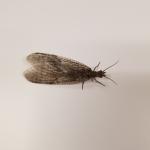 Dobsonfly: These large insects are members of the Order Megaloptera, Family Corydalidae. Everything about them is impressive: they reach up to 5 inches in length with large, veined wings, and unlike the female dobsonfly pictured here in this photo, males can have sickle-shaped mandibles that reach up to a whopping 1.6 inches in length (in species such as the eastern dobsonfly, Corydalus cornutus). Although impressive, the size of the male’s mandibles makes them ineffective at biting. Female dobsonflies, however, can deliver a painful (but not medically significant) bite if harassed. Immature dobsonflies are also skilled biters, if harassed. (So like with many insects, leave them alone, and they will return the favor.) These insects have a rudimentary form of complete metamorphosis, so there is an egg, larva, pupa, and adult stage. Eggs are gray, cylindrical, and laid in clusters (averaging 1,000 eggs/cluster) arranged in layers and then covered with a fluid from the tip of the female’s abdomen. This fluid is applied clear, and dries white, making the egg masses look like bird droppings. Larvae are aquatic and often referred to as hellgrammites. They possess tracheal gills in addition to spiracles which allow them to breathe both in and out of the water. Yellow-orange pupae are found out of the water, either nearby or up to 50 feet away if required to find a suitable location to pupate (under rocks, logs, or other debris). Adults emerge and are short lived (approx. 3 days for males and 10 days for females). Adults are attracted to lights and are nocturnal and common near bodies of water. Larvae feed on soft bodied aquatic insects such as immature caddisflies and blackflies. These insects are not pests, and although they may be intimidating, they should be preserved.
Dobsonfly: These large insects are members of the Order Megaloptera, Family Corydalidae. Everything about them is impressive: they reach up to 5 inches in length with large, veined wings, and unlike the female dobsonfly pictured here in this photo, males can have sickle-shaped mandibles that reach up to a whopping 1.6 inches in length (in species such as the eastern dobsonfly, Corydalus cornutus). Although impressive, the size of the male’s mandibles makes them ineffective at biting. Female dobsonflies, however, can deliver a painful (but not medically significant) bite if harassed. Immature dobsonflies are also skilled biters, if harassed. (So like with many insects, leave them alone, and they will return the favor.) These insects have a rudimentary form of complete metamorphosis, so there is an egg, larva, pupa, and adult stage. Eggs are gray, cylindrical, and laid in clusters (averaging 1,000 eggs/cluster) arranged in layers and then covered with a fluid from the tip of the female’s abdomen. This fluid is applied clear, and dries white, making the egg masses look like bird droppings. Larvae are aquatic and often referred to as hellgrammites. They possess tracheal gills in addition to spiracles which allow them to breathe both in and out of the water. Yellow-orange pupae are found out of the water, either nearby or up to 50 feet away if required to find a suitable location to pupate (under rocks, logs, or other debris). Adults emerge and are short lived (approx. 3 days for males and 10 days for females). Adults are attracted to lights and are nocturnal and common near bodies of water. Larvae feed on soft bodied aquatic insects such as immature caddisflies and blackflies. These insects are not pests, and although they may be intimidating, they should be preserved.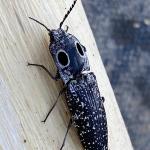
 Eyed Elater/Eastern Eyed Click Beetle: This impressive insect is a type of click beetle, in the Order Coleoptera, Family Elateridae. Often referred to as the eyed elater or eastern eyed click beetle, Alaus oculatus adults are impressive when found. Unlike other click beetle species, it is important to note that the larvae (wireworms) of the eastern eyed click beetle are not crop pests. The larvae of this particular species are actually predators of other beetle larvae, such as those of wood-boring beetles found in decaying wood. Does that make them a beneficial insect? Some argue not really, since they are predators of other insects that are not considered to be pests. So the eyed click beetle wireworms are neither pests nor directly beneficial, yet they should be preserved. This species is known to much of the eastern United States. The false eye spots on the pronotum of adults are characteristic to this genus, and very large in Alanus oculatus when compared with other closely related species. Larvae are large, heavily sclerotized, with a nearly black head and the last four abdominal segments are a dark brown. Larvae are often found in the stumps or rotting wood of oak, cherry, and apple. The eyed elater undergoes complete metamorphosis (egg, larva, pupa, and adult). Click beetles are also known for their ability to jump without using their legs. To return to their feet, capsized click beetles use a hinge mechanism that is locked and releases abruptly to launch the insect into the air. Studies have shown, however, that the chances of the beetle actually “landing on its feet” using this mechanism are roughly 50/50.
Eyed Elater/Eastern Eyed Click Beetle: This impressive insect is a type of click beetle, in the Order Coleoptera, Family Elateridae. Often referred to as the eyed elater or eastern eyed click beetle, Alaus oculatus adults are impressive when found. Unlike other click beetle species, it is important to note that the larvae (wireworms) of the eastern eyed click beetle are not crop pests. The larvae of this particular species are actually predators of other beetle larvae, such as those of wood-boring beetles found in decaying wood. Does that make them a beneficial insect? Some argue not really, since they are predators of other insects that are not considered to be pests. So the eyed click beetle wireworms are neither pests nor directly beneficial, yet they should be preserved. This species is known to much of the eastern United States. The false eye spots on the pronotum of adults are characteristic to this genus, and very large in Alanus oculatus when compared with other closely related species. Larvae are large, heavily sclerotized, with a nearly black head and the last four abdominal segments are a dark brown. Larvae are often found in the stumps or rotting wood of oak, cherry, and apple. The eyed elater undergoes complete metamorphosis (egg, larva, pupa, and adult). Click beetles are also known for their ability to jump without using their legs. To return to their feet, capsized click beetles use a hinge mechanism that is locked and releases abruptly to launch the insect into the air. Studies have shown, however, that the chances of the beetle actually “landing on its feet” using this mechanism are roughly 50/50.
Insects and Other Arthropods of Public Health Concern:
- Deer Tick/Blacklegged Tick: Check out the archived FREE TickTalk with TickReport webinars available here: https://ag.umass.edu/landscape/education-events/webinars . Previous webinars including information about deer ticks and associated diseases, ticks and personal protection, and updates from the Laboratory of Medical Zoology are archived at the link above.
The next webinar will be held on July 8, 2020: The Facts about Powassan Virus
Dr. Stephen Rich, Professor of Microbiology and Director of the UMass Laboratory of Medical Zoology, and Dr. Saravanan Thangamani, Professor of Microbiology and Immunology at Upstate Medical University in Syracuse, NY discuss what is currently known about tick-borne viruses, including Powassan virus. Dr. Thangamani studies the serosurveillance of vector-borne (tick and mosquito) diseases including the effect of co-infection on the clinical outcome of Lyme disease and Powassan encephalitis.
Ixodes scapularis nymphs (immatures) are active, and may be encountered at this time, through August. Nymphs will have already taken a blood meal, and therefore can be infected with disease causing pathogens. It is important to protect yourself against ticks and be especially vigilant for tiny, difficult to see nymphs. For images of all deer tick life stages, along with an outline of the diseases they carry, visit: http://www.tickencounter.org/tick_identification/deer_tick .
Anyone working in the yard and garden should be aware that there is the potential to encounter deer ticks. The deer tick or blacklegged tick can transmit Lyme disease, human babesiosis, human anaplasmosis, and other diseases. Preventative activities, such as daily tick checks, wearing appropriate clothing, and permethrin treatments for clothing (according to label instructions) can aid in reducing the risk that a tick will become attached to your body. If a tick cannot attach and feed, it will not transmit disease. For more information about personal protective measures, visit: http://www.tickencounter.org/prevention/protect_yourself .
Due to unprecedented circumstances of the global pandemic, the University of Massachusetts has mandated work furloughs for all university staff. Unfortunately, this order comes at the annual peak of tick activity, and hence TickReport testing will not be available during the furlough. Effective at 11:59PM on 3-June-2020, until 12:01AM on 19-June-2020, TickReport will not be accepting new orders. For a full statement from TickReport, please visit: https://www.tickreport.com . Please contact TickReport with further questions and updates on the status of their service.
- Mosquitoes: According to the Massachusetts Bureau of Infectious Disease and Laboratory Science and the Department of Public Health, there are at least 51 different species of mosquito found in Massachusetts. Mosquitoes belong to the Order Diptera (true flies) and the Family Culicidae (mosquitoes). As such, they undergo complete metamorphosis, and possess four major life stages: egg, larva, pupa, and adult. Adult mosquitoes are the only stage that flies and many female mosquitoes only live for 2 weeks (although the life cycle and timing will depend upon the species). Only female mosquitoes bite to take a blood meal, and this is so they can make eggs. Mosquitoes need water to lay their eggs in, so they are often found in wet or damp locations and around plants. Different species prefer different habitats. It is possible to be bitten by a mosquito at any time of the day, and again timing depends upon the species. Many are particularly active from just before dusk, through the night, and until dawn. Mosquito bites are not only itchy and annoying, but they can be associated with greater health risks. Certain mosquitoes vector pathogens that cause diseases such as West Nile virus (WNV) and eastern equine encephalitis (EEE).
For more information about mosquitoes in Massachusetts, visit: https://www.mass.gov/service-details/mosquitoes-in-massachusetts
There are ways to protect yourself against mosquitoes, including wearing long-sleeved shirts and long pants, keeping mosquitoes outside by using tight-fitting window and door screens, and using insect repellents as directed. Products containing the active ingredients DEET, permethrin, IR3535, picaridin, and oil of lemon eucalyptus provide protection against mosquitoes.
For more information about mosquito repellents, visit: https://www.mass.gov/service-details/mosquito-repellents and https://www.cdc.gov/features/stopmosquitoes

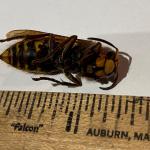 Wasps/Hornets: Many are noticing the spring time “awakening” of various species of wasps/hornets in Massachusetts at this time. Many wasps are predators of other arthropods, including pest insects such as certain caterpillars that feed on trees and shrubs. Adult wasps hunt prey and bring it back to their nest where young are being reared, as food for the immature wasps. A common such example are the paper wasps (Polistes spp.) who rear their young on chewed up insects. They may be seen searching plants for caterpillars and other soft-bodied larvae to feed their young. Paper wasps can sting, and will defend their nests, which are open-celled paper nests that are not covered with a papery “envelope”. These open-celled nests may be seen hanging from eaves or other outdoor building structures. Aerial yellow jackets and hornets create large aerial nests that are covered with a papery shell or “envelope”. Common yellow jacket species include those in the genus Vespula. Dolichovespula maculata is commonly known as the baldfaced hornet, although it is not a true hornet. The European hornet (Vespa crabro) is three times the size of a yellow jacket and may be confused for the Asian giant hornet (Vespa mandarinia). The European hornet is known to Massachusetts, but the Asian giant hornet is not. If you are concerned that you have found or photographed an Asian giant hornet, please report it here: https://massnrc.org/pests/report.aspx . A helpful ID tool, although developed for Texas by the USDA, depicts common look-a-like species that we also have in MA that can be confused for the Asian giant hornet and is found here: https://agrilife.org/lubbock/files/2020/05/Asian_Giant_Hornet_Look-alikes_101_Xanthe_Shirley.pdf Paper wasps and aerial yellowjackets overwinter as fertilized females (queens) and a single female produces a new nest annually in the late spring. Nests are abandoned at the end of the season. It is this annual behavior of queens starting new nests, laying eggs, and rearing new wasps to assist in colony/nest development that may lead people to believe that wasp/yellow jacket numbers are high at this time of year. While populations may fluctuate and insect survival may have been aided by a mild winter (although that is not always true for all species), it is difficult to tell if these insects are more numerous this year, or just that they are more noticeable now that nest construction and brood development are under way for the season. Either way, some people are allergic to stinging insects, so care should be taken around wasp/hornet nests. Unlike the European honeybee (Apis mellifera), wasps and hornets do not have barbed stingers, and therefore can sting repeatedly when defending their nests. It is best to avoid their nests, and if that cannot be done and assistance is needed to remove them, consult a professional.
Wasps/Hornets: Many are noticing the spring time “awakening” of various species of wasps/hornets in Massachusetts at this time. Many wasps are predators of other arthropods, including pest insects such as certain caterpillars that feed on trees and shrubs. Adult wasps hunt prey and bring it back to their nest where young are being reared, as food for the immature wasps. A common such example are the paper wasps (Polistes spp.) who rear their young on chewed up insects. They may be seen searching plants for caterpillars and other soft-bodied larvae to feed their young. Paper wasps can sting, and will defend their nests, which are open-celled paper nests that are not covered with a papery “envelope”. These open-celled nests may be seen hanging from eaves or other outdoor building structures. Aerial yellow jackets and hornets create large aerial nests that are covered with a papery shell or “envelope”. Common yellow jacket species include those in the genus Vespula. Dolichovespula maculata is commonly known as the baldfaced hornet, although it is not a true hornet. The European hornet (Vespa crabro) is three times the size of a yellow jacket and may be confused for the Asian giant hornet (Vespa mandarinia). The European hornet is known to Massachusetts, but the Asian giant hornet is not. If you are concerned that you have found or photographed an Asian giant hornet, please report it here: https://massnrc.org/pests/report.aspx . A helpful ID tool, although developed for Texas by the USDA, depicts common look-a-like species that we also have in MA that can be confused for the Asian giant hornet and is found here: https://agrilife.org/lubbock/files/2020/05/Asian_Giant_Hornet_Look-alikes_101_Xanthe_Shirley.pdf Paper wasps and aerial yellowjackets overwinter as fertilized females (queens) and a single female produces a new nest annually in the late spring. Nests are abandoned at the end of the season. It is this annual behavior of queens starting new nests, laying eggs, and rearing new wasps to assist in colony/nest development that may lead people to believe that wasp/yellow jacket numbers are high at this time of year. While populations may fluctuate and insect survival may have been aided by a mild winter (although that is not always true for all species), it is difficult to tell if these insects are more numerous this year, or just that they are more noticeable now that nest construction and brood development are under way for the season. Either way, some people are allergic to stinging insects, so care should be taken around wasp/hornet nests. Unlike the European honeybee (Apis mellifera), wasps and hornets do not have barbed stingers, and therefore can sting repeatedly when defending their nests. It is best to avoid their nests, and if that cannot be done and assistance is needed to remove them, consult a professional.
Woody ornamental insect and non-insect arthropod pests to consider, a selected few:
- Asian Longhorned Beetle: (Anoplophora glabripennis, ALB) Look for signs of an ALB infestation which include perfectly round exit holes (about the size of a dime), shallow oval or round scars in the bark where a female has chewed an egg site, or sawdust-like frass (excrement) on the ground nearby host trees or caught in between branches. Be advised that other, native insects may create perfectly round exit holes or sawdust-like frass, which can be confused with signs of ALB activity.
The regulated area for Asian longhorned beetle is 110 miles2 encompassing Worcester, Shrewsbury, Boylston, West Boylston, and parts of Holden and Auburn. If you believe you have seen damage caused by this insect, such as exit holes or egg sites, on susceptible host trees like maple, please call the Asian Longhorned Beetle Eradication Program office in Worcester, MA at 508-852-8090 or toll free at 1-866-702-9938.
To report an Asian longhorned beetle find online or compare it to common insect look-alikes, visit: https://massnrc.org/pests/albreport.aspx or https://www.aphis.usda.gov/pests-diseases/alb/report .
- White Spotted Pine Sawyer (WSPS): Monochamus scutellatus adults can emerge in late May throughout July, depending on local temperatures. This is a native insect in Massachusetts and is usually not a pest. Larvae develop in weakened or recently dead conifers, particularly eastern white pine (Pinus strobus). However, the white spotted pine sawyer looks very similar to the invasive Asian Longhorned Beetle, Anoplophora glabripennis, ALB. ALB adults do not emerge in Massachusetts until July and August. Beginning in July, look for the key difference between WSPS and ALB adults, which is a white spot in the top center of the wing covers (the scutellum) on the back of the beetle. White spotted pine sawyer will have this white spot, whereas Asian longhorned beetle will not. Both insects can have other white spots on the rest of their wing covers; however, the difference in the color of the scutellum is a key characteristic. See the Asian longhorned beetle entry above for more information about that non-native insect.
- Arborvitae Leafminer: In New England and eastern Canada, four species of leafminers are known to infest arborvitae. These include Argyresthia thuiella, A. freyella, A. aureoargentella, and Coleotechnites thujaella. The arborvitae leafminer, A. thuiella, is the most abundant of these and has the greatest known range when compared to the others. (It is also found in the Mid-Atlantic States and as far west as Missouri). Moths of this species appear from mid-June to mid-July and lay their eggs. The damage caused by all of these species is nearly identical. Trees, however, have been reported to lose up to 80% of their foliage due to arborvitae leafminer and still survive. At least 27 species of parasites have been reported as natural enemies of arborvitae leafminers, the most significant of which may be a parasitic wasp (Pentacnemus bucculatricis). Arborvitae leafminer damage causes the tips of shoots and foliage to turn yellow and brown. If infestations are light, prune out infested tips.
- Azalea Sawflies: There are a few species of sawflies that impact azaleas. Johnson and Lyon's Insects that Feed on Trees and Shrubs mentions three of them. Amauronematus azaleae was first reported in New Hampshire in 1895 and is likely found in most of New England. Adults of this species are black with some white markings and wasp-like. Generally green larvae feed mostly on mollis hybrid azaleas. Remember, sawfly caterpillars have at least enough abdominal prolegs to spell “sawfly” (so 6 or more prolegs). Adults are present in May, and females lay their eggs and then larvae hatch and feed through the end of June. There is one generation per year. Nematus lipovskyi has been reared from swamp azalea (Rhododendron viscosum). Adults of that species have been collected in April (in states to the south) and May (in New England) and larval feeding is predominantly in late April and May in Virginia and June in New England. One generation of this species occurs per year, and most mollis hybrid azaleas can be impacted. A third species, Arge clavicornis, is found as an adult in July and lays its eggs in leaf edges in rows. Larvae are present in August and September. Remember, Bacillus thuringiensis Kurstaki does not manage sawflies.
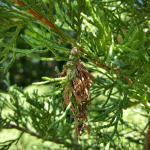 Bagworm: Thyridopteryx ephemeraeformis is a native species of moth whose larvae construct bag-like coverings over themselves with host plant leaves and twigs. This insect overwinters in the egg stage, within the bags of deceased females from last season. Eggs may hatch and young larvae are observed feeding around mid-June, or roughly between 600-900 GDD’s. Remove and destroy overwintering bags before June. In certain areas across MA in 2019, increased populations of bagworms were observed and reported. More information can be found here: https://ag.umass.edu/landscape/fact-sheets/bagworm
Bagworm: Thyridopteryx ephemeraeformis is a native species of moth whose larvae construct bag-like coverings over themselves with host plant leaves and twigs. This insect overwinters in the egg stage, within the bags of deceased females from last season. Eggs may hatch and young larvae are observed feeding around mid-June, or roughly between 600-900 GDD’s. Remove and destroy overwintering bags before June. In certain areas across MA in 2019, increased populations of bagworms were observed and reported. More information can be found here: https://ag.umass.edu/landscape/fact-sheets/bagworm- Boxwood Leafminer: Monarthropalpus flavus partly grown fly larvae overwinter in the leaves of susceptible boxwood. Yellowish mines may be noticeable on the undersides of leaves. This insect grows rapidly in the spring, transforming into an orange-colored pupa. After pupation, adults will emerge and white colored pupal cases may hang down from the underside of leaves where adults have emerged. Adults may be observed swarming hosts between 300-650 GDD’s, or roughly the end of May through June. Most cultivars of Buxus sempervirens and B. microphylla are thought to be susceptible. If installing new boxwoods this spring, resistant cultivars such as ‘Vardar Valley’ and ‘Winter Gem’ are good choices at sites where this insect has been a problem.
- Boxwood Mite: Eurytetranychus buxi overwinter as tiny eggs on boxwood leaves and hatch mid-spring. These mites are tiny (about the size of a period) and difficult to detect. Feeding may cause plants to appear off-color. If management is deemed necessary, the timing for treatment may be between 245-600 GDD’s.
- Boxwood Psyllid: Psylla buxi feeding can cause cupping of susceptible boxwood leaves. Leaf symptoms/damage may remain on plants for up to two years. English boxwood may be less severely impacted by this pest. Eggs overwinter, buried in budscales, and hatch around budbreak of boxwood. Eggs may hatch around 80 GDD’s. Foliar applications may be made between 290-440 GDD’s. However, the damage caused by this insect is mostly aesthetic. Therefore, no management may be necessary.
- Dogwood Borer: Synanthedon scitula is a species of clearwing moth whose larvae bore not only into dogwood (Cornus), but hosts also include flowering cherry, chestnut, apple, mountain ash, hickory, pecan, willow, birch, bayberry, oak, hazel, myrtle, and others. Kousa dogwood appear to be resistant to this species. Signs include the sloughing of loose bark, brown frass, particularly near bark cracks and wounds, dead branches, and adventitious growth. The timing of adult emergence can be expected when dogwood flower petals are dropping and weigela begins to bloom. Adult moth flights continue from then until September. Emergence in some hosts (ex. apple) appears to be delayed, but this differs depending upon the location in this insect’s range. Eggs are laid singly, or in small groups, on smooth and rough bark. Female moths preferentially lay eggs near wounded bark. After hatch, larvae wander until they find a suitable entrance point into the bark. This includes wounds, scars, or branch crotches. This insect may also be found in twig galls caused by other insects or fungi. Larvae feed on phloem and cambium. Fully grown larvae are white with a light brown head and approx. ½ inch long. Pheromone traps and lures are useful for determining the timing of adult moth emergence and subsequent management.
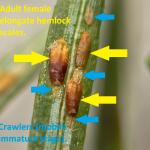 Elongate Hemlock Scale: Fiorinia externa is found on eastern, Carolina, and Japanese hemlock, as well as yew, spruce, and fir. The elongate hemlock scale may overwinter in various life stages, and overlap of many developmental stages at any given time can be observed throughout much of the season. Dormant oil applications for this pest can occur according to label instructions in April, roughly between 7-120 GDD’s. Treatments for the crawler, or mobile, stage of this insect may be made in late May through mid-June, or between 360-700 GDD’s, base 50°F. Nitrogen fertilizer applications may make elongate hemlock scale infestations worse.
Elongate Hemlock Scale: Fiorinia externa is found on eastern, Carolina, and Japanese hemlock, as well as yew, spruce, and fir. The elongate hemlock scale may overwinter in various life stages, and overlap of many developmental stages at any given time can be observed throughout much of the season. Dormant oil applications for this pest can occur according to label instructions in April, roughly between 7-120 GDD’s. Treatments for the crawler, or mobile, stage of this insect may be made in late May through mid-June, or between 360-700 GDD’s, base 50°F. Nitrogen fertilizer applications may make elongate hemlock scale infestations worse.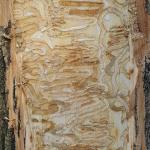 Emerald Ash Borer: (Agrilus planipennis, EAB) Since March 2020, the Massachusetts Department of Conservation and Recreation has confirmed a total of at least 116 communities in Massachusetts that have known populations of emerald ash borer. A map of these locations across the state may be found here: https://ag.umass.edu/fact-sheets/emerald-ash-borer .
Emerald Ash Borer: (Agrilus planipennis, EAB) Since March 2020, the Massachusetts Department of Conservation and Recreation has confirmed a total of at least 116 communities in Massachusetts that have known populations of emerald ash borer. A map of these locations across the state may be found here: https://ag.umass.edu/fact-sheets/emerald-ash-borer .
This wood-boring beetle readily attacks ash (Fraxinus spp.) including white, green, and black ash and has also been found developing in white fringe tree (Chionanthus virginicus) and has been reported in cultivated olive (Olea europaea). Adult insects of this species will not be present at this time of year. Signs of an EAB infested tree may include (at this time) D-shaped exit holes in the bark (from adult emergence in previous years), “blonding” or lighter coloration of the ash bark from woodpecker feeding (chipping away of the bark as they search for larvae beneath), and serpentine galleries visible through splits in the bark, from larval feeding beneath. Positive identification of an EAB-infested tree may not be possible with these signs individually on their own.
For further information about this insect, please visit: https://ag.umass.edu/fact-sheets/emerald-ash-borer . If you believe you have located EAB-infested ash trees, particularly in an area of Massachusetts not identified on the map provided, please report here: http://massnrc.org/pests/pestreports.htm .
- Eriophyid Mites: these insect relatives are known to create different types of leaf galls on certain host plants. The crimson erineum mite or Eriophyes elongates is one of my favorites. This insect can be found on the leaves of sugar maple, creating felt patches on the upper leaf surface that appear pink, or a deep crimson red. The crimson erineum mite was seen on sugar maple in Chesterfield, MA on 5/28/2020. Like the vast majority of leaf galls, the crimson erineum mite does not cause significant injury to its host plant, and therefore management is not necessary.
 Euonymus Caterpillar: Yponomeuta cagnagella is of European origin and widespread in distribution throughout Europe. It was first reported in North America in Ontario in 1967. The euonymus caterpillars (larvae) feed in groups and envelop the foliage of the host plant in webs as they feed. Hosts include: Euonymus europaeus (tree form), E. kiautschovicus, E. alatus, and E. japonicus. Mature caterpillars are just under an inch in length, creamy yellow-gray in color with black spots and a black head capsule. By late June, these larvae pupate in white, oval-shaped cocoons which are typically oriented together vertically either on host plants or non-hosts in the area. Cocoons can be found in cracks and crevices, or webbed together leaves. The adult moth emerges in late June in most locations. The adult female secretes a gummy substance over her eggs which will harden, making them even more difficult to see. Eggs hatch by mid-August, at which time the tiny larvae prepare to overwinter beneath their eggshell-like covering. These larvae are inactive until the following year, when caterpillars group together to feed on newly emerging leaves, creating a mess of webs as they feed. There is one generation per year. Plants may be partially or entirely defoliated. Management of young, actively feeding caterpillars with Bacillus thuringiensis is possible if deemed necessary, however many species of Euonymus are considered invasive themselves.
Euonymus Caterpillar: Yponomeuta cagnagella is of European origin and widespread in distribution throughout Europe. It was first reported in North America in Ontario in 1967. The euonymus caterpillars (larvae) feed in groups and envelop the foliage of the host plant in webs as they feed. Hosts include: Euonymus europaeus (tree form), E. kiautschovicus, E. alatus, and E. japonicus. Mature caterpillars are just under an inch in length, creamy yellow-gray in color with black spots and a black head capsule. By late June, these larvae pupate in white, oval-shaped cocoons which are typically oriented together vertically either on host plants or non-hosts in the area. Cocoons can be found in cracks and crevices, or webbed together leaves. The adult moth emerges in late June in most locations. The adult female secretes a gummy substance over her eggs which will harden, making them even more difficult to see. Eggs hatch by mid-August, at which time the tiny larvae prepare to overwinter beneath their eggshell-like covering. These larvae are inactive until the following year, when caterpillars group together to feed on newly emerging leaves, creating a mess of webs as they feed. There is one generation per year. Plants may be partially or entirely defoliated. Management of young, actively feeding caterpillars with Bacillus thuringiensis is possible if deemed necessary, however many species of Euonymus are considered invasive themselves.
Want to see euonymus caterpillars in action?! I bet you’ve never seen so many of these caterpillars in one place! Check out Episode 3 of InsectXaminer: https://ag.umass.edu/landscape/education-events/insectxaminer .
- Euonymus Scale: Unaspis euonymi is an armored scale that can be found on euonymus, holly, bittersweet, and pachysandra. This insect can cause yellow spotting on leaves, dieback, and distorted bark. Dormant oil applications can be made between 35-120 GDD’s or roughly from mid-April to early-May. For crawlers, early June timing is suggested between 533-820 GDD’s. (Eggs begin to hatch in early June.)
 European Elm Scale: Gossyparia spuria is a type of felt scale and was reported to UMass Extension as active in Quincy, MA on 6/3/20. First noted in New York in 1884, this non-native scale is now widespread in North America and is found on native and European elms, but also rarely on hackberry and Zelkova. This insect can cause yellowing of foliage, premature leaf drop, and eventually dieback on its host. Honeydew and thus sooty mold are produced. The females observed in Quincy, MA have produced a ring of white fibers around their black, oval bodies. By the end of June, these females will lay eggs that hatch into bright yellow crawlers, which will disperse to the midrib and leaf veins on the underside of elm leaves where they will remain to feed. Crawlers are tiny and magnification is necessary to observe. Natural enemies such as parasitic wasps and predatory insects have been reported as successful in managing this insect.
European Elm Scale: Gossyparia spuria is a type of felt scale and was reported to UMass Extension as active in Quincy, MA on 6/3/20. First noted in New York in 1884, this non-native scale is now widespread in North America and is found on native and European elms, but also rarely on hackberry and Zelkova. This insect can cause yellowing of foliage, premature leaf drop, and eventually dieback on its host. Honeydew and thus sooty mold are produced. The females observed in Quincy, MA have produced a ring of white fibers around their black, oval bodies. By the end of June, these females will lay eggs that hatch into bright yellow crawlers, which will disperse to the midrib and leaf veins on the underside of elm leaves where they will remain to feed. Crawlers are tiny and magnification is necessary to observe. Natural enemies such as parasitic wasps and predatory insects have been reported as successful in managing this insect.
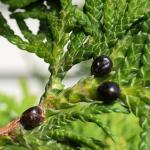
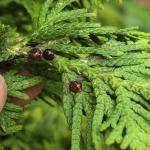 Fletcher Scale: Parthenolecanium fletcheri is a soft scale pest of yew, juniper, and arborvitae. Feeding scales, especially on yew, result in honeydew and sooty mold, needle yellowing, and at times, premature needle drop. There is one generation per year. Overwintered second instar nymphs can be targeted between 38-148 GDD’s, base 50°F. Nymphs develop and adult females lay eggs (on average 500-600) in May that hatch by June. Dead females conceal egg masses beneath. Crawlers migrate short distances to branches and may be concentrated on certain branches of a particular plant.
Fletcher Scale: Parthenolecanium fletcheri is a soft scale pest of yew, juniper, and arborvitae. Feeding scales, especially on yew, result in honeydew and sooty mold, needle yellowing, and at times, premature needle drop. There is one generation per year. Overwintered second instar nymphs can be targeted between 38-148 GDD’s, base 50°F. Nymphs develop and adult females lay eggs (on average 500-600) in May that hatch by June. Dead females conceal egg masses beneath. Crawlers migrate short distances to branches and may be concentrated on certain branches of a particular plant.
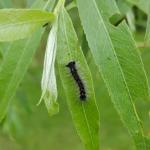 Gypsy Moth:(Lymantria dispar) thanks to the gypsy moth caterpillar killing fungus, Entomophaga maimaiga, the recent outbreak of gypsy moth in Massachusetts has come to an end! Most locations in Massachusetts will not see damaging or even noticeable populations of this insect in 2020. However, that does not mean the occasional egg mass won’t be seen in certain areas of the state. Egg hatch was observed and reported with photo evidence in Shelburne Falls, MA on 5/4/2020.Shadbush (Amelanchier spp.) was reported as in full bloom at the same time in that area. A young gypsy moth caterpillar was seen feeding on willow in Chesterfield, MA on 6/3/20, despite the relative lack of overwintering gypsy moth egg masses in the area. The impact of gypsy moth in this particular hilltown in Hampshire County has been negligible.
Gypsy Moth:(Lymantria dispar) thanks to the gypsy moth caterpillar killing fungus, Entomophaga maimaiga, the recent outbreak of gypsy moth in Massachusetts has come to an end! Most locations in Massachusetts will not see damaging or even noticeable populations of this insect in 2020. However, that does not mean the occasional egg mass won’t be seen in certain areas of the state. Egg hatch was observed and reported with photo evidence in Shelburne Falls, MA on 5/4/2020.Shadbush (Amelanchier spp.) was reported as in full bloom at the same time in that area. A young gypsy moth caterpillar was seen feeding on willow in Chesterfield, MA on 6/3/20, despite the relative lack of overwintering gypsy moth egg masses in the area. The impact of gypsy moth in this particular hilltown in Hampshire County has been negligible.
Gypsy moth has been in Massachusetts since the 1860's. This invasive insect from Europe often goes unnoticed, thanks to population regulation provided by the entomopathogenic fungus, E. maimaiga, as well as a NPV virus specific to gypsy moth caterpillars. (And to a lesser extent many other organisms, including other insects, small mammals, and birds who feed on gypsy moth.) However, if environmental conditions do not favor the life cycle of the fungus, outbreaks of gypsy moth caterpillars are possible. (Such as most recently from 2015-2018, with a peak in the gypsy moth population in 2017 in Massachusetts.)
Missing gypsy moth already? Check out Episode 1 of InsectXaminer to reminisce about the 2015-2018 outbreak of this insect: https://ag.umass.edu/landscape/education-events/insectxaminer
- Hemlock Looper: Two species of geometrid moths in the genus Lambdina are native insects capable of defoliating eastern hemlock, balsam fir, and white spruce. Adult moths lay their eggs on the trunk and limbs of hosts in September and October, and eggs will hatch by late May or early June. (L. fiscellaria caterpillars may be active between 448-707 GDD’s.) Monitor susceptible hosts for small, inch-worm like caterpillars. Where populations are low, no management is necessary. Hemlock loopers have several effective natural enemies.
- Hemlock Woolly Adelgid: Adelges tsugae is present on eastern and Carolina hemlock. The overwintering hemlock woolly adelgid generation (sistens) is present through mid-spring and produces the spring generation (progrediens) which will be present from early spring through mid-summer. HWA, unlike many other insects, does most of its feeding over the winter. Eggs may be found in woolly masses at the base of hemlock needles beginning in mid-March. Each woolly mass is created by a female who may then lay 50-300 eggs. Eggs hatch and crawlers may be found from mid-March through mid-July. Infested trees may be treated with foliar sprays in late April to early May, using Japanese quince as a phenological indicator. Systemic applications may be made in the spring and fall, or when soil conditions are favorable for translocation to foliage. Nitrogen fertilizer applications may make hemlock woolly adelgid infestations worse.
- Holly Leafminers: Seven species of leaf miners feed on holly. Phytomyza ilicicola is usually referred to as the native holly leafminer. This species is known to feed on Ilex opaca, I. crenata, and related cultivars; however, it only lays its eggs in American holly (Ilex opaca). Some research suggests that the native holly leafminer may lay its eggs in other Ilex species, but that the larvae are unable to complete their development. This insect is found throughout the native range of its host plants. Larvae overwinter in leaf mines and pupation occurs in March and April and adult emergence by mid-May (192-298 GDD’s, base 50°F). Adult flies are known to emerge over a period of 6 or so weeks in the spring. Females lay eggs using their ovipositor on the underside of newly formed leaves. A tiny green blister forms on the leaf as the first symptom of injury. Larvae hatch from the egg and create a narrow mine that may appear brown from the upper leaf surface. Mines are broadened in the fall and a large blotch is completed in the winter. Larvae are yellow maggots and reach 1.5 mm. in length when mature. Current year’s mines are easily overlooked due to the slow feeding patterns of the larvae. Premature leaf drop may occur. Remove and destroy mined leaves before May. Phytomyza ilicis is usually only referred to as the holly leafminer, and it is a non-native species introduced from Europe and only feeds on Ilex aquifolium. (The native holly leaf miner does not develop in I. aquifolium.) The biology and damage this insect causes is similar to that of the native holly leafminer, with the exception of the fact that eggs are laid in the midvein of the leaf and young larvae tunnel in the vein until the fall. Remove and destroy mined leaves before May. Adults may be present mid-late May (246-448 GDD’s, base 50°F).
- Honeylocust Plant Bug: Diaphnocoris chlorionis feeding results in tiny yellowish-brownish spots on leaves, leaf distortion, and in some cases, defoliation. (There are at least 7 species of plant bugs that feed on honeylocust, Gleditsia triacanthos.) There is one generation per year. Immatures and adults feed on foliage and light to moderately damaged foliage may persist throughout the growing season. Honeylocust plant bugs overwinter as eggs laid just beneath the bark surface of 2 and 3 year old twigs. Eggs hatch just after vegetative bugs of the host begin to open. Young nymphs crawl to the opening leaflets and begin feeding and the most significant damage occurs at that time, when the insect is hidden from view. Nymphs develop into adults around May-July. This insect can be targeted between 58-246 GDD’s, base 50°F.
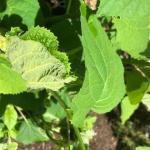
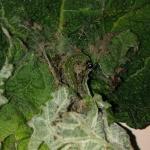 Hydrangea Leaftier: Olethreutes ferriferana is a moth in the Family Tortricidae whose caterpillars use silk applied to the edges of two newly expanding hydrangea leaves to tie them together to create an envelope-like structure within which they feed. These leaf-envelopes tend to occur near the tips of plant stems and can be very obvious. As a result, the two tied leaves may not fully expand when compared to healthy, not impacted leaves. Caterpillars are green and partially transparent with a black head capsule and a black thoracic shield which is found on the top of the body segment located directly behind the head. It is likely that caterpillars will soon be pupating. Pupation is thought to occur in the ground nearby host plants, so the insect drops to the ground to pupate where it overwinters. Adults are found in the spring and are small white and brown moths. Eggs are laid on branch tips of various species of hydrangea. Only one generation is known per year. This insect, although creating visible and interesting damage to hydrangea, is not usually considered to be a serious pest – although occasional localized problematic populations have been reported. Removing leaf-envelopes in the early spring or pinching them to kill the caterpillar within can help reduce populations on individual plants.
Hydrangea Leaftier: Olethreutes ferriferana is a moth in the Family Tortricidae whose caterpillars use silk applied to the edges of two newly expanding hydrangea leaves to tie them together to create an envelope-like structure within which they feed. These leaf-envelopes tend to occur near the tips of plant stems and can be very obvious. As a result, the two tied leaves may not fully expand when compared to healthy, not impacted leaves. Caterpillars are green and partially transparent with a black head capsule and a black thoracic shield which is found on the top of the body segment located directly behind the head. It is likely that caterpillars will soon be pupating. Pupation is thought to occur in the ground nearby host plants, so the insect drops to the ground to pupate where it overwinters. Adults are found in the spring and are small white and brown moths. Eggs are laid on branch tips of various species of hydrangea. Only one generation is known per year. This insect, although creating visible and interesting damage to hydrangea, is not usually considered to be a serious pest – although occasional localized problematic populations have been reported. Removing leaf-envelopes in the early spring or pinching them to kill the caterpillar within can help reduce populations on individual plants.
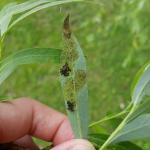 Imported Willow Leaf Beetle: Plagiodera versicolora adult beetles overwinter near susceptible hosts. Adult beetles will chew holes and notches in the leaves of willow once they become available. Imported willow leaf beetle adults were observed feeding and mating in Chesterfield, MA on 5/20/2020. Adults continue to feed and mate on 5/26/2020 and egg laying has been observed. Females lay yellow eggs in clusters on the undersides of leaves. While clusters of yellow eggs could still be found, tiny larvae have hatched and are beginning to skeletonize willow leaves, as observed on 6/3/20 in Chesterfield, MA. By 6/7/20, imported willow leave beetle larvae have grown larger and are skeletonizing willow leaves in Chesterfield, MA. Larvae are slug-like and bluish-green in color. They will feed in clusters and skeletonize the leaves. Most plants can tolerate the feeding from this insect, and foliage will appear brown. Repeated yearly feeding can be an issue, in which case management of the young larvae may be necessary. Take care with treatment in areas near water.
Imported Willow Leaf Beetle: Plagiodera versicolora adult beetles overwinter near susceptible hosts. Adult beetles will chew holes and notches in the leaves of willow once they become available. Imported willow leaf beetle adults were observed feeding and mating in Chesterfield, MA on 5/20/2020. Adults continue to feed and mate on 5/26/2020 and egg laying has been observed. Females lay yellow eggs in clusters on the undersides of leaves. While clusters of yellow eggs could still be found, tiny larvae have hatched and are beginning to skeletonize willow leaves, as observed on 6/3/20 in Chesterfield, MA. By 6/7/20, imported willow leave beetle larvae have grown larger and are skeletonizing willow leaves in Chesterfield, MA. Larvae are slug-like and bluish-green in color. They will feed in clusters and skeletonize the leaves. Most plants can tolerate the feeding from this insect, and foliage will appear brown. Repeated yearly feeding can be an issue, in which case management of the young larvae may be necessary. Take care with treatment in areas near water.- Lacebugs: Stephanitis spp. lacebugs such as S. pyriodes can cause severe injury to azalea foliage. S. rhododendri can be common on rhododendron and mountain laurel. S. takeyai has been found developing on Japanese Andromeda, Leucothoe, Styrax, and willow. Stephanitis spp. lace bug activity should be monitored through September. Before populations become too large, treat with a summer rate horticultural oil spray as needed. Be sure to target the undersides of the foliage in order to get proper coverage of the insects. Certain azalea and Andromeda cultivars may be less preferred by lace bugs.
- Lecanium Scales (Oak): Parthenolecanium quercifex overwinters as a second instar nymph on oak twigs. Females will begin feeding and mature in the spring, from mid-April to early May and eggs may be laid between late May and into June. Eggs hatch in June or early July and crawlers migrate to host plant leaves where they spend the summer and migrate as second instars back to host plant twigs in the fall. Mid-April to early-May (35-145 GDD’s) for dormant oil applications.
- Lilac Borer: Podosesia syringae is a clearwing moth pest of lilac, privet, fringetree, and ash. (It is also known as the ash borer, not to be confused with the emerald ash borer.) Adults mimic paper wasps. Larvae are wood-boring, and signs and symptoms include branch dieback, holes, and occasionally, sawdust-like frass accumulated on bark. Larvae bore into stems, trunks, and branches, chewing an irregularly shaped entrance hole. Peak adult moth flights may occur in the northern portion of this insect’s range in June and is usually over by August 1st. Pheromone traps can be used to time adult emergence. Adult females lay flattened, oval, and tan eggs that are deposited singly or in clusters on bark crevices, ridges, and sometimes smooth bark; but usually laid in or near wounds in the bark. On average, 395 eggs are laid by each female. After hatch, larvae chew into the bark and feed laterally and then vertically in phloem tissue. Larvae overwinter in tunnels in the final instar and resume feeding in the spring. Adults emerge through a round exit hole (4-5 mm. in diameter). This insectmay be targeted between 200-299 GDD’s, base 50°F.
 Lily Leaf Beetle: Lilioceris lilii adults overwinter in sheltered places. As soon as susceptible hosts such as Lilium spp. (Turk’s cap, tiger, Easter, Asiatic, and Oriental lilies) and Fritillaria spp. break through the ground, the adult lily leaf beetles are known to feed on the new foliage. (Note: daylilies are not hosts.)Typically, in May, mating will occur and each female will begin to lay 250-450 eggs in neat rows on the underside of the foliage. If there are only a few plants in the garden, hand picking and destroying overwintering adults can help reduce local garden-level populations at this time. For more information about this insect, visit the newly updated fact sheet: https://ag.umass.edu/landscape/fact-sheets/lily-leaf-beetle
Lily Leaf Beetle: Lilioceris lilii adults overwinter in sheltered places. As soon as susceptible hosts such as Lilium spp. (Turk’s cap, tiger, Easter, Asiatic, and Oriental lilies) and Fritillaria spp. break through the ground, the adult lily leaf beetles are known to feed on the new foliage. (Note: daylilies are not hosts.)Typically, in May, mating will occur and each female will begin to lay 250-450 eggs in neat rows on the underside of the foliage. If there are only a few plants in the garden, hand picking and destroying overwintering adults can help reduce local garden-level populations at this time. For more information about this insect, visit the newly updated fact sheet: https://ag.umass.edu/landscape/fact-sheets/lily-leaf-beetle
Want to learn more about lily leaf beetle’s life cycle and learn to recognize adults, larvae, and eggs? Take 3 minutes to watch Episode 2 of InsectXaminer, here: https://ag.umass.edu/landscape/education-events/insectxaminer .
- Magnolia Scale: Neolecanium cornuparvum overwinters as first instar nymphs which are elliptical, and dark slate gray in color and can usually be found on the undersides of 1 and 2 year old twigs. Nymphs may molt by late April or May and again by early June at which time the scales may be purple in color. Eventually nymphs secrete a white powdery layer of wax over their bodies.
- Rhododendron Borer: Synanthedon rhododendri is one of the smallest of the native clearwing moths. Rhododendrons are preferred hosts, although mountain laurel, and deciduous azaleas can be heavily infested, especially if they are planted in close proximity to rhododendrons. Injury may be first noticed in the fall (leaves lose their sheen, then become pale green, then olive, then chlorotic) and can look similar to drought stress. On branches that seem to be stunted, look at limb crotches, scars, and other irregularities for sawdust stuck on bark or on the ground beneath these areas. In late May and early June, holes may contain pupal shed skins extending halfway out. Moth emergence occurs in the late-spring, early-summer. After mating, female moths seek out suitable egg laying locations (preferring wounded areas or limb crotches). The female lays her eggs and dies. Eggs hatch and larvae tunnel into the inner bark where they feed in tunnels that become packed with reddish frass pellets. By late fall, larvae move to the sapwood where they overwinter and resume feeding by mid-March. Pupation occurs in the spring and there is one generation per year. Prune out and destroy infested branches before late May/June. Monitor for adults in mid-May (192-298 GDD’s, base 50°F).
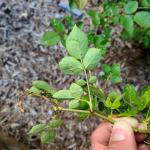
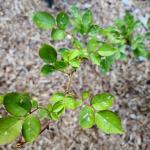 Roseslugs: Two species of sawfly can be found on the leaves of roses at this time. These small, caterpillar-like larvae will skeletonize the upper leaf surface and leave a “window-pane” like pattern behind. When present in large numbers, these insects are capable of defoliating their entire host. Management options include an insecticidal soap spray or a product containing spinosad. Roseslug sawflies were viewed in Hinsdale, MA on 6/7/2020.
Roseslugs: Two species of sawfly can be found on the leaves of roses at this time. These small, caterpillar-like larvae will skeletonize the upper leaf surface and leave a “window-pane” like pattern behind. When present in large numbers, these insects are capable of defoliating their entire host. Management options include an insecticidal soap spray or a product containing spinosad. Roseslug sawflies were viewed in Hinsdale, MA on 6/7/2020.
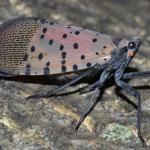 Spotted Lanternfly: (Lycorma delicatula, SLF) is not known to occur in Massachusetts landscapes (no established populations are known in MA at this time). However, due to the great ability of this insect to hitchhike using human-aided movement, it is important that we remain vigilant in Massachusetts and report any suspicious findings. Spotted lanternfly reports can be sent here:https://massnrc.org/pests/slfreport.aspx
Spotted Lanternfly: (Lycorma delicatula, SLF) is not known to occur in Massachusetts landscapes (no established populations are known in MA at this time). However, due to the great ability of this insect to hitchhike using human-aided movement, it is important that we remain vigilant in Massachusetts and report any suspicious findings. Spotted lanternfly reports can be sent here:https://massnrc.org/pests/slfreport.aspx
For a map of known, established populations of SLF as well as detections outside of these areas where individual finds of spotted lanternfly have occurred (but no infestations are present), visit: https://nysipm.cornell.edu/environment/invasive-species-exotic-pests/spotted-lanternfly/ This map depicts an individual find of spotted lanternfly at a private residence in Boston, MA that was reported by the MA Department of Agricultural Resources on February 21, 2019. More information about this detection in Boston, where no established infestation was found, is provided here: https://www.mass.gov/news/state-agricultural-officials-urge-residents-to-check-plants-for-spotted-lanternfly
This insect is a member of the Order Hemiptera (true bugs, cicadas, hoppers, aphids, and others) and the Family Fulgoridae, also known as planthoppers. The spotted lanternfly is a non-native species first detected in the United States in Berks County, Pennsylvania and confirmed on September 22, 2014.
The spotted lanternfly is considered native to China, India, and Vietnam. It has been introduced as a non-native insect to South Korea and Japan, prior to its detection in the United States. In South Korea, it is considered invasive and a pest of grapes and peaches. The spotted lanternfly has been reported from over 70 species of plants, including the following: tree of heaven (Ailanthus altissima) (preferred host), apple (Malus spp.), plum, cherry, peach, apricot (Prunus spp.), grape (Vitis spp.), pine (Pinus spp.), pignut hickory (Carya glabra), sassafras (Sassafras albidum), serviceberry (Amelanchier spp.), slippery elm (Ulmus rubra), tulip poplar (Liriodendron tulipifera), white ash (Fraxinus americana), willow (Salix spp.), American beech (Fagus grandifolia), American linden (Tilia americana), American sycamore (Platanus occidentalis), big-toothed aspen (Populus grandidentata), black birch (Betula lenta), black cherry (Prunus serotina), black gum (Nyssa sylvatica), black walnut (Juglans nigra), dogwood (Cornus spp.), Japanese snowbell (Styrax japonicus), maple (Acer spp.), oak (Quercus spp.), and paper birch (Betula papyrifera).
The adults and immatures of this species damage host plants by feeding on sap from stems, leaves, and the trunks of trees. In the springtime in Pennsylvania (late April - mid-May) nymphs (immatures) are found on smaller plants and vines and new growth of trees and shrubs. Third and fourth instar nymphs migrate to the tree of heaven and are observed feeding on trunks and branches. Trees may be found with sap weeping from the wounds caused by the insect’s feeding. The sugary secretions (excrement) created by this insect may coat the host plant, later leading to the growth of sooty mold. Insects such as wasps, hornets, bees, and ants may also be attracted to the sugary waste created by the lanternflies, or sap weeping from open wounds in the host plant. Host plants have been described as giving off a fermented odor when this insect is present.
Adults are present by the middle of July in Pennsylvania and begin laying eggs by late September and continue laying eggs through late November and even early December in that state. Adults may be found on the trunks of trees such as the tree of heaven or other host plants growing in close proximity to them. Egg masses of this insect are gray in color and look similar in some ways to gypsy moth egg masses.
Host plants, bricks, stone, lawn furniture, recreational vehicles, and other smooth surfaces can be inspected for egg masses. Egg masses laid on outdoor residential items such as those listed above may pose the greatest threat for spreading this insect via human aided movement.
For more information about the spotted lanternfly, visit this fact sheet: https://ag.umass.edu/landscape/fact-sheets/spotted-lanternfly .
- Spruce Bud Scale: Physokermes piceae is a pest of Alberta and Norway spruce, among others. Immatures overwinter on the undersides of spruce needles, dormant until late March. By April, females may move to twigs to complete the rest of their development. Mature scales are reddish brown, globular, 3 mm. in diameter, and found in clusters of 3-8 at the base of new twig growth. They closely resemble buds and are often overlooked. Crawlers are present around June.
- Spruce Spider Mite: Oligonychus ununguis is a cool-season mite that becomes active in the spring from tiny eggs that have overwintered on host plants. Hosts include spruce, arborvitae, juniper, hemlock, pine, Douglas-fir, and occasionally other conifers. This particular species becomes active in the spring and can feed, develop, and reproduce through roughly June. When hot, dry summer conditions begin, this spider mite will enter a summer-time dormant period (aestivation) until cooler temperatures return in the fall. This particular mite may prefer older needles to newer ones for food. When damaging spruce spider mite populations are known from last season, dormant oil applications can be made (when temperatures are appropriate according to label instructions) between 7-121 GDD’s, base 50°F (April). Magnification is required to view spruce spider mite eggs. Tapping host plant branches over white paper may be a useful tool when scouting for spider mite presence. (View with a hand lens.) Spider mite damage may appear on host plant needles as yellow stippling and occasionally fine silk webbing is visible.
- Taxus Mealybug: Dysmicoccus wistariae will produce honeydew and lead to sooty mold growth, yellowing of needles, and sparsely foliated plants. Eventual dieback may be possible. This species is commonly associated with taxus in New England, but can be occasionally found on dogwood, rhododendron, Prunus spp., maple, andromeda, and crabapple. These mealybugs are found on stems and branches and particularly like to congregate at branch crotches. Taxus mealybug feeds in the inner bark tissue of the trunk and branches. Adult females are present from June to August and give birth to living young in the summer. Immatures overwinter. A single generation may occur per year in New England, but areas to the south can have multiple generations of this insect. Management may be targeted between 246-618 GDD’s, base 50°F. Horticultural oil and neem oil may be used.
- Twolined Chestnut Borer: Agrilus bilineatus is a native jewel beetle (also known as a flatheaded borer) in the Family Buprestidae. This insect is also in the same genus as the invasive emerald ash borer. The twolined chestnut borer is native to Massachusetts, much of New England, and the eastern United States. This species has one generation per year and adults are typically active from April – August, depending upon location and temperature. Adults will conduct some maturation feeding on oak prior to mating. Females will lay clusters of tiny eggs in the cracks and crevices of bark. Larvae hatch from the eggs in 1-2 weeks and burrow through the bark into the cambium, where they feed in a similar manner to the emerald ash borer, creating meandering galleries as they feed. (The galleries of the twolined chestnut borer can be straight in very stressed trees.) Larvae typically mature by August – October and burrow to the outer bark where they create a chamber in which they overwinter. Pupation occurs the following spring and adults emerge through D-shaped exit holes that are approximately 1/5 inch wide. In the northern extent of this insect’s range, they can take 2 years to complete their life cycle. Larvae of this insect have been recorded from eastern white oak, common post oak, burr oak, scarlet oak, northern red oak, and eastern black oak. Adults have been recorded on fir and pin oak. These insects are attracted to stressed host plants and typically become a secondary factor in the decline of the tree.
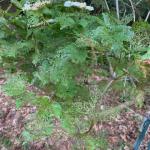
 Viburnum Leaf Beetle: Pyrrhalta viburni is a beetle in the family Chrysomelidae that is native to Europe, but was found in Massachusetts in 2004. Viburnum leaf beetle overwinters as eggs laid in capped pits on the newest growth of susceptible viburnum branches. Egg hatch occurs in late-April to early-May as temperatures warm and foliage becomes available. Monitor for larvae in mid-May (80-120 GDD’s). Recently, reports of viburnum leaf beetle larval feeding to UMass Extension have increased, likely because feeding damage is more apparent at this time. Feeding larvae were seen and reported on 5/31/20 in Southampton, MA and Pelham, MA. This beetle feeds exclusively on many different species of viburnum, which includes, but is not limited to, susceptible plants such as V. dentatum, V. nudum, V. opulus, V. propinquum, and V. rafinesquianum. Some viburnum have been observed to have varying levels of resistance to this insect, including but not limited to V. bodnantense, V. carlesii, V. davidii, V. plicatum, V. rhytidophyllum, V. setigerum, and V. sieboldii. More information about viburnum leaf beetle may be found at http://www.hort.cornell.edu/vlb/ .
Viburnum Leaf Beetle: Pyrrhalta viburni is a beetle in the family Chrysomelidae that is native to Europe, but was found in Massachusetts in 2004. Viburnum leaf beetle overwinters as eggs laid in capped pits on the newest growth of susceptible viburnum branches. Egg hatch occurs in late-April to early-May as temperatures warm and foliage becomes available. Monitor for larvae in mid-May (80-120 GDD’s). Recently, reports of viburnum leaf beetle larval feeding to UMass Extension have increased, likely because feeding damage is more apparent at this time. Feeding larvae were seen and reported on 5/31/20 in Southampton, MA and Pelham, MA. This beetle feeds exclusively on many different species of viburnum, which includes, but is not limited to, susceptible plants such as V. dentatum, V. nudum, V. opulus, V. propinquum, and V. rafinesquianum. Some viburnum have been observed to have varying levels of resistance to this insect, including but not limited to V. bodnantense, V. carlesii, V. davidii, V. plicatum, V. rhytidophyllum, V. setigerum, and V. sieboldii. More information about viburnum leaf beetle may be found at http://www.hort.cornell.edu/vlb/ .- Woolly Elm Aphid: Eriosoma americanum females lay a single egg in the cracks and crevices of elm bark, where the egg overwinters. Eggs hatch on elm in the spring as leaves are unfolding. Aphids may be active from 121-246 GDD’s, base 50°F on elm. A young, wingless female hatched from the egg feeds on the underside of leaf tissue. This female aphid matures and gives birth to 200 young, all females, without mating. These aphids feed, and the elm leaf curls around them and protects them. By the end of June, winged migrants mature and find serviceberry hosts. Another set of females is produced. These new females crawl to and begin feeding on the roots of serviceberry. Multiple generations occur on the roots of serviceberry through the summer.
Concerned that you may have found an invasive insect or suspicious damage caused by one? Need to report a pest sighting? If so, please visit the Massachusetts Introduced Pests Outreach Project: http://massnrc.org/pests/pestreports.htm .
A note about Tick Awareness: deer ticks (Ixodes scapularis), the American dog tick (Dermacentor variabilis), and the lone star tick (Amblyomma americanum) are all found throughout Massachusetts. Each can carry their own complement of diseases. Anyone working in tick habitats (wood-line areas, forested areas, and landscaped areas with ground cover) should check themselves regularly for ticks while practicing preventative measures. Have a tick and need it tested? Visit the web page of the UMass Laboratory of Medical Zoology (https://www.tickreport.com/ ) and click on the blue Order a TickReport button for more information.
Reported by Tawny Simisky, Extension Entomologist, UMass Extension Landscape, Nursery, & Urban Forestry Program
Concerned that you may have found an invasive insect or suspicious damage caused by one? Need to report a pest sighting? If so, please visit the Massachusetts Introduced Pests Outreach Project: http://massnrc.org/pests/pestreports.htm .
Weeds
A comment about the use of spray surfactants with herbicide applications follows. The rule is: “If an herbicide requires the addition of a surfactant, then one should be added per the label; if a surfactant is not required, then one should not be added.” If a required surfactant is not used, the efficacy can be significantly decreased to the point that the herbicide might not work. If a surfactant is added that is not needed, herbicide selectivity can be decreased, leading to the possibility of injury or death of normally tolerant plants.
Do not delay, treat garlic mustard, Alliaria petiolate, now. Plants have matured to a point were seedpods have formed and the seeds are not yet mature as they are still green. Garlic mustard is a biennial and herbicide applications at this time of year will control second year plants before they go to seed as well as the first year seedlings.
Tree seedlings are continuing to germinate, and some locations may have seedlings that are 2 to 3 inches tall. These seedlings can be treated with pelargonic acid, ScytheTM. Another option would be to cut these seedlings with a gas, electric or battery powered hedge shear at the soil or mulch surface. The organic/non-chemical products do not translocate and therefore will not provide effective control of these young tree seedlings. Tree seedlings in turf areas will be controlled with mowing, so an herbicide application is not necessary.
New growth expansion of poison ivy continues. It’s still a little early to treat; wait until the end of flowering in late June to mid-September.
Do not attempt to control Japanese knotweed, Polygonum cuspidatum, at this time as herbicide applications are not effective. In preparation for a late season herbicide application, cut or mow stands of knotweed to the ground in late May and early June. This practice is done to facilitate herbicide application by removing the dried stems from the previous year’s growth and will control plant height so knotweed will be shorter at the time of treatment in late summer. There is also some indication that the plant’s carbohydrate reserves may be reduced with this early season mowing.
Report by Randy Prostak, Weed Specialist, UMass Extension Landscape, Nursery and Urban Forestry Program
Landscape Turf
Insects
White grubs: The window of opportunity for preventive diamide applications (chlorantraniliprole) is about to end. This application targets young larvae of the new generation and ideally should be conducted before June 15. The next window of opportunity for annual grub preventive management will be in July when adults are flying and laying eggs. During that time, the recommended options are neonicotinoids, which target hatching young larvae.
By now, most white grub species are finishing their development and getting ready to transform to adults. So, no curative applications are recommended at this time. European chafers are expected to be flying very soon (mid-June in Massachusetts).
May /June (Phyllophaga spp.) beetles were flying at the end of the last week (Fig.1,2). Adult beetles are attracted to lights and often dead beetles can be spotted near the lights the next day. May/June beetles take three years to complete development from eggs to adult beetles. These are an occasional and usually localized problem for turf. Adults feed on shade and forest tree foliage, and often prefer oaks. Similar to annual white grub species, May/June beetle larvae feed on grass roots, and can potentially cause damage. In addition, larvae can feed on the roots of shade, forest and even Christmas trees, which can be damaging to the young trees.
Billbugs: During the past 2-3 weeks we have observed increased billbug adult activity. Adult billbugs usually overwinter in sheltered areas and come back to turf at this time of year to feed, mate and lay eggs. Small (1-2 instar) billbug larvae feed inside the plant. Later larvae come out of the plant and feed on the crowns, causing severe turf damage. Damage is most apparent in July, especially if the weather conditions are dry (Fig 3). If a high-density population was noticed last year, now is a good time to consider preventive application. Systemic insecticides (neonicotinoids and diamides) are the best option for the larvae feeding inside of the stem.
Submitted by: Dr. Olga Kostromytska and Dr. Pat Vittum
Cultural Practices
Humidity and Water Management are Critical for Lawn Disease Prevention: Turf disease development is strongly influenced by environmental conditions within the turf canopy and the soil around the root zone. Temperature plays a role of course; for instance, red thread is typically seen in cooler weather, while brown patch appears in the heat of the summer. Free moisture and humidity also play a key role in promoting disease. Most fungi that cause plant diseases require free moisture to be available on plant surfaces for a certain amount of time for spore germination and infection to occur, and high humidity further promotes disease development.
While we can’t do anything about the weather, there are things that turf professionals can do to decrease humidity and free moisture in the turf microclimate and make conditions less hospitable to pathogenic fungi. This involves active effort to keep leaf wetness periods as short as possible, and facilitating rapid drying of foliage after rain or irrigation. This can be accomplished by increasing air circulation and sun exposure on the turf; factors that are best considered prior to turf establishment but may be improved for existing sites by strategically pruning or removing trees and shrubs. Examples of more targeted practices include dragging a hose over turf in the early morning to speed drying by knocking dew off the leaf blades.
Watering is best done in the early morning, as increasing temperatures and sunlight will promote rapid drying of foliage as the day progresses. To maintain growth during summer, a general guideline for lawns in Southern New England is one inch of moisture input per week from either precipitation, supplemental irrigation, or a combination thereof. Watering deeply and infrequently is the best way to manage soil moisture in lawns. This practice also promotes the development of deep roots, an important characteristic that makes turf less susceptible to environmental stress and diseases. Excessively wet soil is not only conducive to numerous diseases, but the exclusion of oxygen in waterlogged soil also impairs proper root function, weakening turf and making it more susceptible to pathogens.
Submitted by: Dr. Angela Madeiras
Additional Resources
To receive immediate notification when the next Landscape Message update is posted, join our email list by emailing your request to eweeks@umext.umass.edu with Subscribe Greeninfo in the subject line, and follow us on Facebook and Twitter.
For a complete listing of upcoming events, see our upcoming educational events https://ag.umass.edu/landscape/upcoming-events
For commercial growers of greenhouse crops and flowers - Check out UMass Extension's Greenhouse Update website
For professional turf managers - Check out Turf Management Updates
For home gardeners and garden retailers - Check out our home lawn and garden resources. UMass Extension also has a Twitter feed that provides timely, daily gardening tips, sunrise and sunset times to home gardeners at twitter.com/UMassGardenClip
New Online Offering from UMass Extension’s Pesticide Education Program:
Are you looking for continuing education contact hours and the 2020 Pesticide Recertification Workshops from UMass Extension’s Pesticide Education Program? Topics include MA Pesticide Laws and Regulations, Pesticide Respirator Fit Test: Train the Trainer, Pesticides and Impacts on Wildlife, Fungicides: Modes of Action and Resistance Management, and more! Cost is $40 per person, per 2.5 hour workshop. To register and to find out more information, visit:
https://www.umass.edu/pested/recertification/current_workshops.htm
Current Massachusetts and University policies have the effect of temporarily suspending most of the on-campus services that we provide, including but not limited to:
- Soil and Plant Nutrient Testing Lab
- Plant Disease Diagnostics Lab
- Weed, Insect, Turfgrass, and Invasive Plant Identification
Until further notice, please do not send or deliver samples to the campus, as we cannot process them.
Diagnostic Services
A UMass Laboratory Diagnoses Landscape and Turf Problems - The UMass Extension Plant Diagnostic Lab is available to serve commercial landscape contractors, turf managers, arborists, nurseries and other green industry professionals. It provides woody plant and turf disease analysis, woody plant and turf insect identification, turfgrass identification, weed identification, and offers a report of pest management strategies that are research based, economically sound and environmentally appropriate for the situation. Accurate diagnosis for a turf or landscape problem can often eliminate or reduce the need for pesticide use. For sampling procedures, detailed submission instructions and a list of fees, see Plant Diagnostics Laboratory . No samples are being accepted at this time.
Soil and Plant Nutrient Testing - The University of Massachusetts Soil and Plant Nutrient Testing Laboratory is located on the campus of The University of Massachusetts at Amherst. Testing services are available to all. The function of the Soil and Plant Nutrient Testing Laboratory is to provide test results and recommendations that lead to the wise and economical use of soils and soil amendments. For complete information, visit the UMass Soil and Plant Nutrient Testing Laboratory web site. Alternatively, call the lab at (413) 545-2311. No samples are being accepted at this time.
Due to unprecedented circumstances of the global pandemic, the University of Massachusetts has mandated work furloughs for all university staff. Unfortunately this order comes at the annual peak of tick activity, and hence TickReport testing will not be available during the furlough. Effective at 11:59PM on 3-June-2020, until 12:01AM on 19-June-2020, TickReport will not be accepting new orders. For a full statement from TickReport, please visit: https://www.tickreport.com . Please contact TickReport with further questions and updates on the status of their service.
Ticks are active any time that temperatures are above freezing! Remember to take appropriate precautions when working and playing outdoors, and conduct daily tick checks. UMass tests ticks for the presence of Lyme disease and other disease pathogens. Learn more
